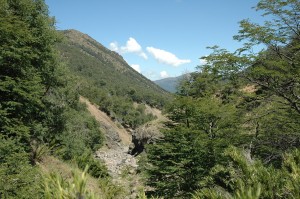 Imagine a place so quiet and peaceful that you can hear your own thoughts or choose to totally disregard them, without the conscious need to meditate. That is what I discovered during a four-day/three-night horseback adventure into the Pehuenche region of the Andes. It was an experience that I will never forget.
Imagine a place so quiet and peaceful that you can hear your own thoughts or choose to totally disregard them, without the conscious need to meditate. That is what I discovered during a four-day/three-night horseback adventure into the Pehuenche region of the Andes. It was an experience that I will never forget.
For the most part, the Andes Mountains had been solely a backdrop to our various treks up, down and around Chile. Although we had been in the “foothills” many times, and had once had a turbulent flight over them, on a connection from Sao Paolo to Santiago, the mountain range itself remained a mystery. So, it was with great excitement and anticipation that a grand, up-close and personal journey was planned with close friends.
The expedition was offered through a collaborative effort of the Pehuenche community, an indigenous people who inhabit the Alto Bio Bio region on the Chilean side, as well as regions across the Argentine border. The cooperative program serves not only as a means to expand their humble economy, but also to expose the outside population to their traditions and way of life. The collective operates under the name of Trekaleyin (http://en.trekaleyin.com, or http://www.trekaleyin.com).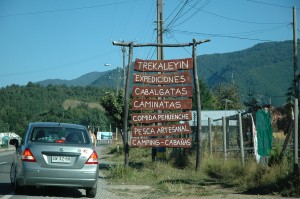
While many different trails and timeframes are offered, we choose the one that would take us into the highland steppes of Antuco, which features some of the highest peaks in the Andes, as well as the greatest variety of vegetation and manificent landscapes along the way.
The first leg of our journey began with a stop at Trekaleyin’s reception office, located in the community of Ralca. The staff provided us with information on the preliminaries of the trip, as well as directions to a small farm in Petril, where we would spend the first night in a cabaña. Transportation to the cabaña, as well as to the community of Trapa Trapa, is available, however we elected to take our own vehicles.
En route to our first destination, we stopped for a quick respite of natural spring water, taken from a small cascade along the paved road. It was to be the beginning of many simple pleasures yet to come.
The small farm with cabaña proved to be one of the simple delights. Located in a valley with the Bio Bio river at its edge and the Andes as a backdrop, the cabaña provided the basic first-night amenities needed for our band of fun-loving six souls to begin to learn to function as a family group.
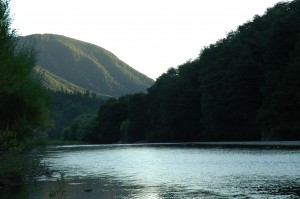 The cabaña featured: one small, main living area with stove, refrigerator, sink, table and chairs; two bedrooms with double bunk beds in one and a double bed in the other; and a bathroom with shower located just before entering the recessed front door.
The cabaña featured: one small, main living area with stove, refrigerator, sink, table and chairs; two bedrooms with double bunk beds in one and a double bed in the other; and a bathroom with shower located just before entering the recessed front door. 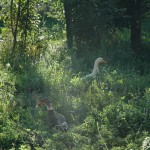
With an hour to spare before dinner, we had time to enjoy the surroundings. There were trees from which to pick fruit, small farm animal life with which to make friends, and the shore of the Queuco River to explore. It was just enough time to build an appetite for the meal that awaited us.
The first night’s dinner was offered at a simple, rustic, wooden structure at a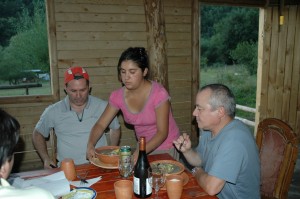 camping ground on the other side of the farm. A long table with benches flanked one side of the room, and an open fire pit provided warmth and atmosphere at the other end. Along the back of the building ran a counter, with a wood burning cook stove in the corner. Numerous large windows allowed everyone to enjoy the view.
camping ground on the other side of the farm. A long table with benches flanked one side of the room, and an open fire pit provided warmth and atmosphere at the other end. Along the back of the building ran a counter, with a wood burning cook stove in the corner. Numerous large windows allowed everyone to enjoy the view.
The dinner de jour was a cazuela (stew) of farm-raised chicken, potatoes, pumpkin and other vegetables with a rich broth, served in clay pottery. In addition to the cazuela, freshly baked tortilla (tortilla in Chile is a bread baked in a fire oven, and not the tortilla shells used for burritos), and Chilean-style salads of tomatoes, onions and cilantro. We elected to bring our own bottle of wine, as well as beers for those who preferred a grain brew.
We enjoyed a long, leisurely meal together and conversations with Marcelo, the camp and cabaña owner, while the fire crackled and the sun slowly set. We were gradually winding down from our normal lives to prepare ourselves to embrace what lay ahead.
Our first night ended with a game of cards, and the men sampling the Jack Daniels that had been carefully wrapped for travel in a backback. Eventually, my eyes grew too tired to see, and I made my way to one of the bunkbeds to drift into slumber, snuggled in the warmth of our sleeping bag. I wanted to be fresh for the first day of horseback travel.
We arose early to shower (it was to be our last real shower for the trip), have a hearty breakfast of scrambled eggs, tortilla, fresh cheese, honey, marmalades, coffee and tea, and then repack for the journey.
Although we had each brought what was thought to be the minimal needed for the trip, Marcelo advised us to not worry about several changes of clothes, and to leave as much behind as possible. We were carrying everything in, and out, on our backs, by horse, and he recommended carrying as little weight as possible. He said that we were going to get dirty anyways, and not to worry.
In the end, I left a second pair of jeans and top, all makeup, and several other sundry items. I wore most of the remaining clothes, which consisted of jeans, cami top, lightweight training jacket, waterproof outer jacket, sneakers and hat. My backpack was reduced to a pair of training pants, long-sleeved top, vest, swimsuit, flipflops, as well as other of the small items listed in “Recommended Gear” at the end of this article. A saddlebag carried water, and other beverages. Our sleeping bags and mattress were also attached to the saddle. By the time we were returning to Trapa Trapa, I was glad to have followed Marcelo’s advice.
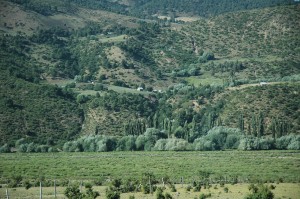 Trapa Trapa was a small, dispersed community of farms, higher up in the hills. The primary source of income is from livestock breeding and farming, and life there is simple, basic, and poor by most standards. However, what was lacking in material possession was abundantly provided in natural ones. The landscapes were incredible, and I found myself becoming seduced by the gentle, unspoiled environment. Indeed, I felt myself becoming embraced by spirit of the Andes itself.
Trapa Trapa was a small, dispersed community of farms, higher up in the hills. The primary source of income is from livestock breeding and farming, and life there is simple, basic, and poor by most standards. However, what was lacking in material possession was abundantly provided in natural ones. The landscapes were incredible, and I found myself becoming seduced by the gentle, unspoiled environment. Indeed, I felt myself becoming embraced by spirit of the Andes itself.
Once our horses were rounded up from various farms (these are true working and well-trained horses),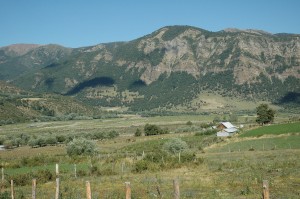 we began our ascent into the higher regions. It felt liberating to be riding again, and with the sun caressing my shoulders, I left all cares behind and opened myself to the experience.
we began our ascent into the higher regions. It felt liberating to be riding again, and with the sun caressing my shoulders, I left all cares behind and opened myself to the experience.
The initial trail wound in and out around the folds of the lower mountain range. At times, the path was so narrow that I could barely imagine how my horse could find footing. However, as we made our ascent, I began to trust his surefootedness, and eventually became accustomed to looking down long drop-offs, without the slightest worry.
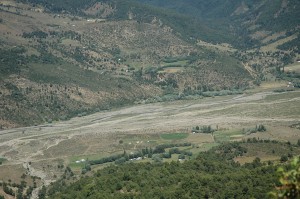 Although the weight of my Nikon D70 was too much for me to manage with the reins, at least this early in the journey, and many magnificent sights were left un-photographed, a stop at a vista lookout allowed me to capture the distance we had traveled, and the valley below. The Andes of Chile lay to one side, and the Andes of Argentina to the other. Both the view and the wind were breathtaking.
Although the weight of my Nikon D70 was too much for me to manage with the reins, at least this early in the journey, and many magnificent sights were left un-photographed, a stop at a vista lookout allowed me to capture the distance we had traveled, and the valley below. The Andes of Chile lay to one side, and the Andes of Argentina to the other. Both the view and the wind were breathtaking.
From the lookout, we pressed on to our first camp site, Camp Pilkinko. My first impression of the camp was that it was a corral for the horses. It wasn’t until I had my feet planted on the ground, and approached the site that I realized that the corral was for us. The posts and rails marked the area for tents, tables and camp fire. The horses remained tied up outside.
There were two creeks a short distance from the campsite, one of which was to be our source for water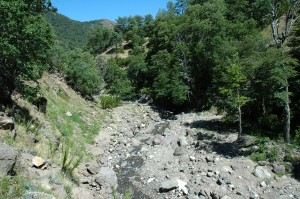 and cleaning. While our guides, Xavier and Manuel prepared a cazuela, we explored their
and cleaning. While our guides, Xavier and Manuel prepared a cazuela, we explored their 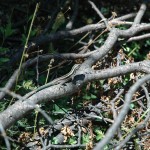 shorelines, scrambling and jumping over rocks. Along the way, I managed to photo a chameleon basking in the sun. His color matched the branch upon which he sat, with a little green to complement the leaves below.
shorelines, scrambling and jumping over rocks. Along the way, I managed to photo a chameleon basking in the sun. His color matched the branch upon which he sat, with a little green to complement the leaves below.
As a rock hound in my childhood, the plethora of different rock types also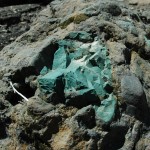 caught my attention. One boulder had a turquoise-colored rock jutting from it. I wasn’t sure what type of rock it is, and am still curious, but time-challenged, to research.
caught my attention. One boulder had a turquoise-colored rock jutting from it. I wasn’t sure what type of rock it is, and am still curious, but time-challenged, to research.
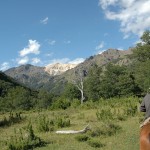 After our mid-day respite, we resaddled to explore the region. Rugged cliffs and hills framed the distance, blue clouds dotted the skies, and araucaria, oaks and other trees prevailed as vegetation.
After our mid-day respite, we resaddled to explore the region. Rugged cliffs and hills framed the distance, blue clouds dotted the skies, and araucaria, oaks and other trees prevailed as vegetation.
The Pehuenche take their name from the araucaria trees that predominate the 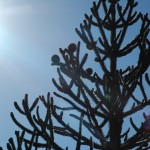 region, pehuen for araucaria, and che for people. They are the People of the Araucaria, and the tree is sacred in their culture. The piñon (pine nut) is a staple of their diet; indeed, the piñon is staple of the Chilean diet. During harvest season, street vending carts everywhere in Chile abound with this delectable nut, which is usually boiled before eaten.
region, pehuen for araucaria, and che for people. They are the People of the Araucaria, and the tree is sacred in their culture. The piñon (pine nut) is a staple of their diet; indeed, the piñon is staple of the Chilean diet. During harvest season, street vending carts everywhere in Chile abound with this delectable nut, which is usually boiled before eaten.
The Pehuenche have a very close and sacred relationship with the Andes, and it was 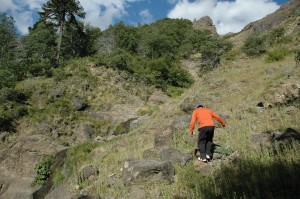 a joy to experience their quiet and reverent interaction. Eventually, we began to adopt our own states of quiet being. While we would be very talkative during meals, our conversations became silent when riding along the various trails. There was so much to take in, to contemplate. The more common sounds heard were onomatopoeias rather than words. If one chose, it was a perfect time to immerse in ones own spirituality.
a joy to experience their quiet and reverent interaction. Eventually, we began to adopt our own states of quiet being. While we would be very talkative during meals, our conversations became silent when riding along the various trails. There was so much to take in, to contemplate. The more common sounds heard were onomatopoeias rather than words. If one chose, it was a perfect time to immerse in ones own spirituality.
After a long and visually enriching ride, we ended back at the camp for a simple meal of tuna, tomatoes and lettuce, tortillas, and cheese. Another bottle of wine was opened, and we rested our tired buns and bones at the table, playing cards and talking until the night was too dark to see. Insomnia was never an issue during this adventure.
The next morning, we pressed on to the second camp, Tripapawe Antu, high up in the Andes. The leg of the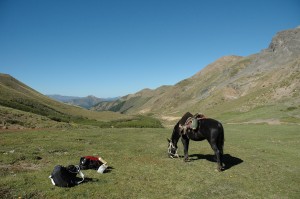 journey, for me, was the most remarkable. If we could have extended our trip, I would have been perfectly happy.
journey, for me, was the most remarkable. If we could have extended our trip, I would have been perfectly happy.
Again, the ruggedness of the trail made use of my camera very difficult. So, I took full advantage of the times that we stopped to rest. The landscape had changed dramatically in the higher altitudes, and I was reminded of elementary school lessons on the types of vegetation that survive at different altitudes.
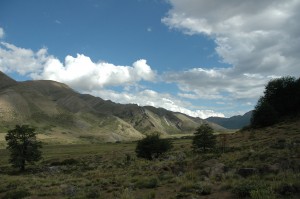 It is this part of the trip that will forever be part of my soul. I can’t begin to explain in words what I felt, saw and experienced, except to say that I was touched to the depth of my being. I found perfect contentment within myself. I found the stillness and the one of being with the universe, that which could never be found in my meditations. It was incredible.
It is this part of the trip that will forever be part of my soul. I can’t begin to explain in words what I felt, saw and experienced, except to say that I was touched to the depth of my being. I found perfect contentment within myself. I found the stillness and the one of being with the universe, that which could never be found in my meditations. It was incredible.
The second camp was more rugged than the first. Instead of tables with benches, cut logs served as chairs, and when grouped together, as tables. Our meals, too, became more simplified, and it was at this point that I began to appreciated the poverty of the Pehuenche. The next trip, which I have no doubt will take place, we will be certain to bring provisions to supplement. It would be the least that we could do for our guides and their families.
I have to say that I enjoyed the second camp more than the first. I loved the remoteness, the views filled with the peaks of the Andes from every angle, and the peace. I grew so easily accustomed to this lifestyle that our first day back in the apartment was such a shock. I remember being literally startled to see houses and the university outside our windows, rather than the mountains. I think that my body returned back to Concepcion before my soul did.
My husband and I had the opportunity to ride alone that afternoon at camp. We were both experienced riders, and the guides were comfortable with placing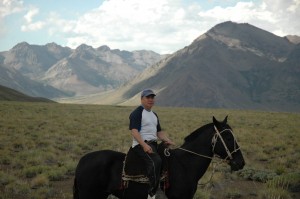 the horses in our capable hands.
the horses in our capable hands.
Earlier in the day, we had had an enjoyable swim in a nearby creek, and it was back to this creek that we rode in the late afternoon. Off in the distance, the rumbles of thunder could be heard, and although there had been discussions about returning to the first camp rather than brave a rainstorm, we remained at the second camp.
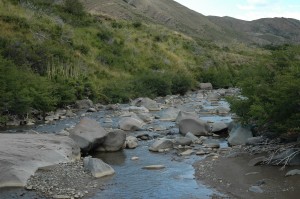 The freedom to ride where we chose was pure bliss, and gave us an opportunity to ride through the open valley and to explore a house off in the distance, on the other side of the creek. When the light began to wan, it was with reluctance that we returned to camp.
The freedom to ride where we chose was pure bliss, and gave us an opportunity to ride through the open valley and to explore a house off in the distance, on the other side of the creek. When the light began to wan, it was with reluctance that we returned to camp.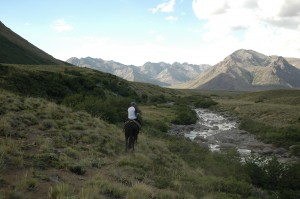
During the evening, after dinner, we drank mate, played cards, talked, laughed, and stood by the fire to keep warm. We had found happiness, not derived from materialism, but from companionship, harmony and the return to the essence of being.
The next morning, our journey back seemed so brief, in comparison to our arrival. The horses knew that we were heading back, and it took most of my strength to keep my horse from galloping all the way home. I had periodically given both him and myself time to run during the trip, and at the end, he want a free rein to do so all the way back to Trapa Trapa.
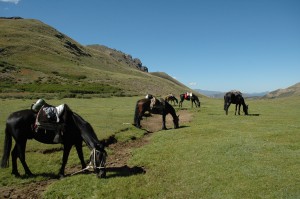 Thankfully, we took one final break to rest the horses and ourselves. It gave me an opportunity to shoot photos one last time, and to prepare myself to say goodbye to the experience. I wanted the experience to last forever, and in many ways, it always will last forever in my heart and soul.
Thankfully, we took one final break to rest the horses and ourselves. It gave me an opportunity to shoot photos one last time, and to prepare myself to say goodbye to the experience. I wanted the experience to last forever, and in many ways, it always will last forever in my heart and soul.
Recommended Gear to Bring
Sleeping bag (with storage bag)
Backpack
Bowl, knife, fork, spoon, cup
Sun block
Hat (make sure it’s one that will stay secure on your head)
Jacket (I wore a breathable, waterproof Columbia jacket with hood)
Shoes appropriate for mountains (most of us wore sneakers)
Sandels or flipflops (I used flipflops in the creek)
Jeans (wore the pair)
Camera (wished that I also had a pocket size for shots when riding)
Swimsuit (used for bathing)
Long sleeve shirt (sleeping at night)
Exercise pants (sleeping at night)
Sunglasses
Snacks (I took raisins, nuts and candybars)
Medications/mini first aid kit
Flashlight (mini)
Air mattress (compact)
Toilet Paper
Personal toiletries
Towel, washcloth
Bottled water (enough for the journey)
Recommended Baggage to Leave Behind
Burdens of the soul